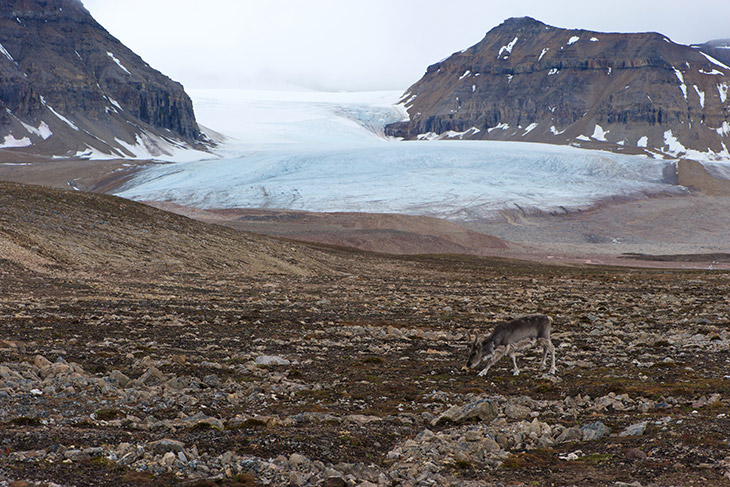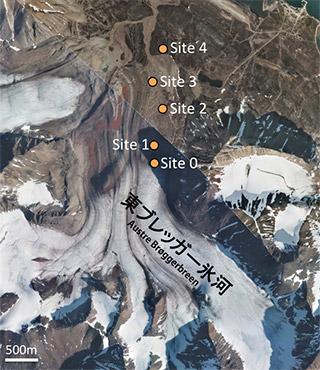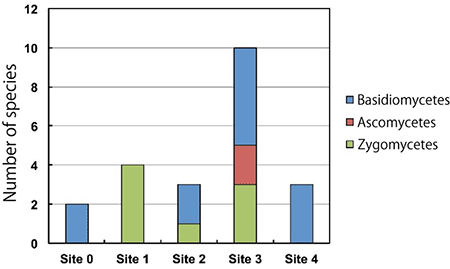National Institute of Polar Research
Mycoflora changes in areas of deglaciation
Released on September 23, 2016 (in Japanese)
Posted on March 31, 2017
National Institute of Polar Research
Dr. Masaharu Tsuji and his colleagues, working with the National Institute of Polar Research, studies fungi in deglaciated areas of Austre Brøggerbreen, Svalbard. They have shown that the composition of fungi here differs greatly depending on the distance to the glaciers terminus. This result indicates that as the glacier retreats, it exposes the underlying rock surface so that the mycoflora on this surface changes and species diversity becomes more abundant with time after the retreat of the glacier.
Many of glacial retreat occur worldwide due to global climate change. After retreating, fresh rock and glacier sediments that are newly exposed at the surface have low amounts of available nutrients. These surfaces become habitats for fungi that can grow under oligotrophic and low temperature conditions. Of these, cold-adapted fungi work as decomposers and play important roles in the nutrient cycle of polar-region ecosystems. Thus, changes in the mycoflora affect the ecological recycling in these regions.

Figure 1: Austre Brøggerbreen, Svalbard. Photo: Yukiko Tanabe
The research team collected soil and glacier samples from five sites (Sites 0-4) within the deglaciated area at varying distances from the glacier terminus (fig. 2), which has receded about 400 m in 74 years at Austre Brøggerbreen. Samples were brought to Japan and then tried isolation of fungi. This examination found only Basidiomycetous yeast at Site 0, which is 7 m upstream of the glacier terminus. However, at Site 1, where the ground has been exposed relatively recently (around 10 years ago), only Zygomycota were isolated. Further at site 2, where the glacier has been absent for around 50 years, in addition to Zygomycota, a species of Basidiomycetous yeast in the genus Mrakia was isolated. At site 3, which has been exposed for about 80 years, Ascomycetous yeast were isolated, in addition to Zygomycota and Basidiomycetous yeast. Furthermore, the amount of nitrogen and carbon found in the samples at sites 1-3 increased further from the glaciers edge.

Figure 2: Research site. The bottom of the photograph is the upstream direction of the glacier

Figure 3: Number of species isolated from each sampling site.
From these results, the process of change in the mycoflora of Austre Brøggerbreen's deglaciated areas was inferred to be the following:
1) The environments created immediately following glacial retreat are colonized by Zygomycota in the genera Mortierella and Mucor. Because these species are known as decomposers of granite, they were therefore considered to supply citrate and malate to the soil by the decomposition of granite that appeared after glacier retreating (Site 1).
2) Utilizing these nutrients, the Basidiomycetous yeast Mrakia becomes colonized. As species in the genus Mrakia secrete various extracellular enzymes such as cellulase and lipase, they decompose cell-wall and cell-membrane remnants and supply carbon to the soil of recently retreated glacier sites (Site 2).
3) After the accumulation of nutrients, species of ascomycetes and basidiomycetes, except for genus Mrakia were considered to grow using the accumulated nutrients (Site 3).
In summary, it is considered that for at least a period of 80 years in this deglaciation area, fungi have contributed to the accumulation of nutrients as their biodiversity gradually increased.
Dr. Tsuji has stated that, "Fungi in polar regions have superior characteristics such as cold active enzymes. They are gathered attention as a microbiological resource". In the future, the research team plans to continue studying the mycoflora of deglaciated areas alongside investigating the industrial use of fungi.
Published Paper
Journal: Mycoscience
Title: Changes in fungal community of Austre Brøggerbreen deglaciation area, Ny-Ålesund, Svalbard, High Arctic
Authors: Masaharu Tsuji1, Jun Uetake1,2, Yukiko Tanabe1,3
1: National Institute of Polar Research, Japan
2: Transdisciplinary Research Integration Center, Japan
3: SOKENDAI (Graduate University for Advanced Studies), Japan
Available online 31 August 2016
DOI: 10.1016/j.myc.2016.07.006
URL: http://dx.doi.org/10.1016/j.myc.2016.07.006
Funder
This study was supported by a Grant-in-Aid for Research Activity Start-up, Japan Society for the Promotion of Science (15H06825), a Grant-in-Aid for Scientific Research (B) (26310213) and a part of Japanese “Arctic Climate Change Research Project” within the GRENE (Green Network of Excellence) Program.
Contact
Public Relations Section
E-mail: kofositu@nipr.ac.jp








